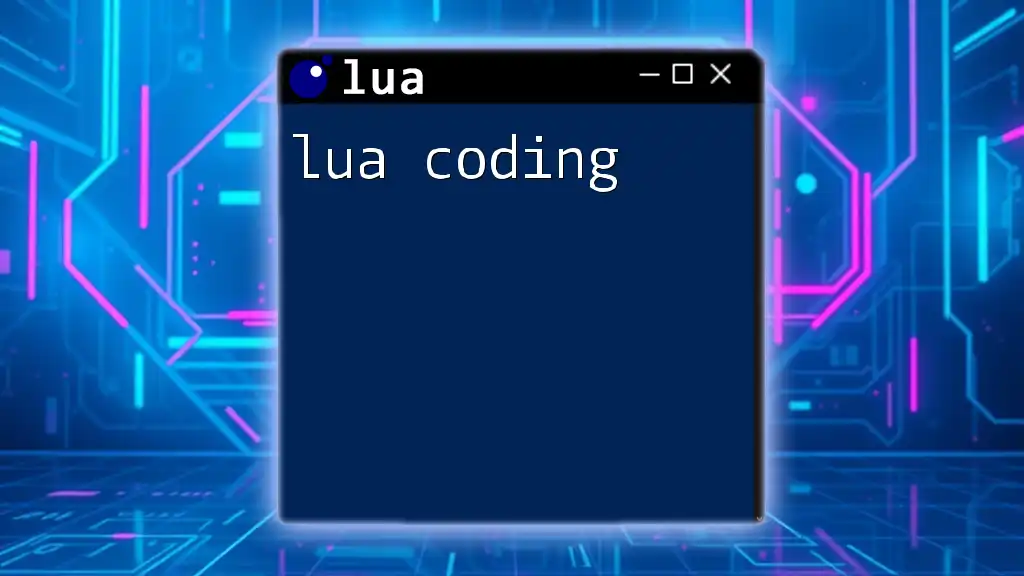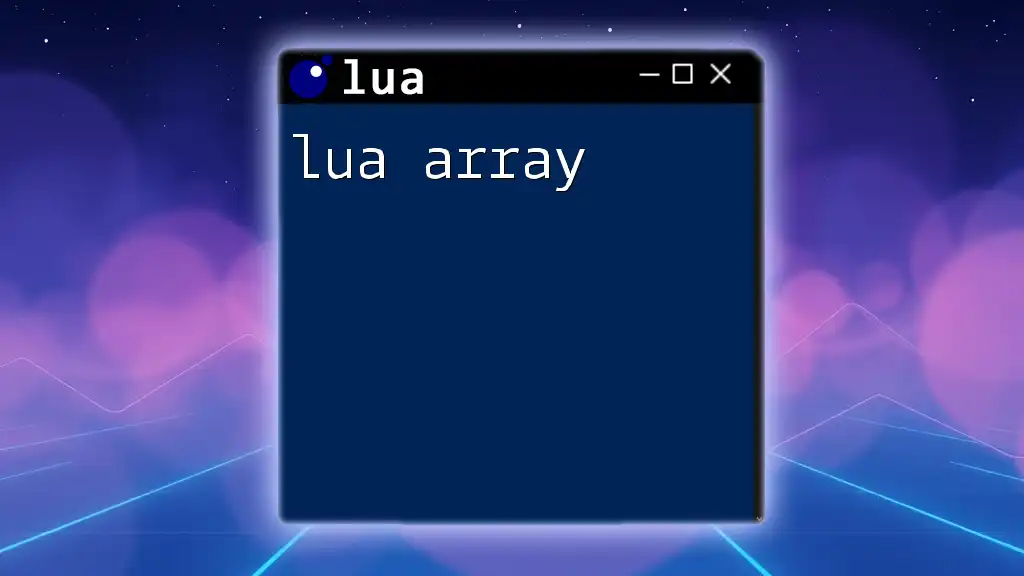Lua Maui is a framework that enables developers to build cross-platform applications using Lua scripting, allowing for efficient and straightforward code management.
Here's a simple example of a Lua script using the Maui framework to create a basic window:
local window = maui.Window {
title = "Hello Lua Maui",
width = 400,
height = 200
}
window:show()
What is Lua Maui?
Lua Maui is an exciting juncture at which the lightweight scripting capabilities of Lua meet the robust, cross-platform features of .NET MAUI (Multi-platform App UI). As developers look for versatile and efficient ways to create applications, understanding this combination becomes essential for building responsive, dynamic applications that run seamlessly on multiple platforms.
Understanding Lua and Maui
What is Lua?
Lua is a flexible, lightweight scripting language designed primarily for extending applications. Its simplicity, portability, and fast performance make it an appealing choice for developers across various domains. With a syntax that’s easy to learn and use, Lua enables rapid prototyping and quick development cycles.
Common Use Cases
Lua shines in several areas:
- Game Development: Thanks to its powerful yet straightforward capabilities, Lua is widely used in game engines (like Unity) to create gameplay logic.
- Embedded Systems: Its small footprint makes it ideal for programming in constrained environments, such as IoT devices.
- Web Applications: Lua can also be embedded into web servers to handle dynamic content generation.
What is Maui?
.NET MAUI (Multi-platform App UI) is a framework that allows developers to build native applications for various platforms (iOS, Android, Windows, macOS) using a single codebase. This framework emphasizes cross-platform user interface development, enabling the use of a single language, C#, resulting in fewer resources spent on application management.
Combining Lua and MAUI
Why Use Lua with MAUI?
Integrating Lua into a MAUI application offers a unique advantage. Lua can manage application logic while MAUI handles the UI aspects, leading to a clear separation of concerns. This combination benefits developers in numerous ways:
- Lightweight scripting for rapid development.
- Dynamic content creation that enhances user experience.
- Flexibility to update Lua scripts without recompiling the entire application, allowing for easier modifications and debugging.

Setting Up Your Development Environment
Prerequisites
Installations Needed
Before diving into Lua Maui development, it’s crucial to have the right tools in place. Here’s what you need:
- Install .NET SDK: Make sure you have the latest .NET SDK installed for MAUI development.
- Install Lua Interpreter: A Lua interpreter, such as PUC-Rio Lua or LuaJIT, is necessary to run your Lua scripts.
Development Tools
Choose an appropriate IDE to facilitate your coding process. Popular choices include:
- Visual Studio: Provides extensive support for .NET MAUI projects.
- Visual Studio Code: A lightweight option with excellent extensibility through plugins.
Project Initialization
Creating a New MAUI Project
Creating a new project in MAUI is straightforward. Follow these steps:
- Open your chosen IDE.
- Create a new project and select the .NET MAUI App template.
- Configure your project settings, ensuring you set the target frameworks appropriately.
You will get a standard project structure that will contain folders for assets, models, views, and more, setting the stage for building your application.

Integrating Lua with MAUI
Adding Lua Support
Lua Bindings
To seamlessly integrate Lua with MAUI, you will need to establish Lua bindings. These bindings facilitate interaction between your Lua scripts and the MAUI environment. Libraries like MoonSharp are recommended for this purpose, as they provide an easy way to execute Lua scripts within a .NET application.
Example: Simple Lua Script Execution
Here is a simple Lua script example:
-- Example Lua script
print("Hello from Lua!")
This snippet demonstrates how to output text from a Lua script. This kind of simple interaction can form the basis of more complex logic within your application.
Communication Between C# and Lua
Function Calls and Data Exchange
One of the powerful features of integrating Lua within a MAUI app is the ability to call Lua functions from C# and vice versa. This cross-language interaction enables rich, interactive applications.
For example, consider a simple Lua function that greets a user:
-- Lua function
function greet(name)
return "Hello, " .. name
end
Corresponding C# code to invoke this Lua function might look like this:
var luaScript = new Lua(); // Assuming Lua is initialized appropriately
luaScript.DoString("function greet(name) return 'Hello, ' .. name end"); // Load Lua function
var message = luaScript.Call("greet", "John"); // Call Lua function
Console.WriteLine(message); // Outputs: Hello, John
This integration exemplifies how Lua can be effectively harnessed to enhance the application's interactivity.

Building a Sample Application
Application Overview
For demonstration purposes, let’s craft a simple application using Lua and MAUI. Imagine a basic calculator application where mathematical operations can be defined and executed in Lua.
Step-by-Step Development
Building the User Interface
Using XAML for UI design ensures a responsive and appealing interface. Start by creating buttons for digits and operations. Here’s how a simple calculator UI might look:
<StackLayout>
<Label x:Name="Display" Text="0" FontSize="32"/>
<Grid>
<!-- Define buttons for digits and operations -->
<Button Text="1" Clicked="OnDigitClicked"/>
<Button Text="2" Clicked="OnDigitClicked"/>
<!-- Add more buttons as needed -->
<Button Text="+" Clicked="OnOperationClicked"/>
</Grid>
</StackLayout>
Integrating Lua for Business Logic
Use Lua to define the logic for operations like addition or multiplication. Here’s how this could be structured:
-- Lua script for calculator operations
function add(a, b)
return a + b
end
function subtract(a, b)
return a - b
end
In your C# code, link these Lua functions to the button click events, allowing dynamic calculation based on user input.

Debugging and Troubleshooting
Common Issues and Solutions
Debugging is a crucial part of development. When scripting in Lua, utilize tools that allow for real-time debugging to catch issues early.
Debugging Lua Scripts in MAUI
To debug Lua scripts within your app, leverage logging mechanisms and error handlers. For instance:
-- Simple error handling in Lua
function safeExecute(func)
local status, err = pcall(func)
if not status then
print("Error: " .. err)
end
end
safeExecute(function()
print("Testing error handling!")
end)
Error Handling
Ensure that you're implementing proper error handling for both Lua and C#. Don’t allow uncaught exceptions to crash your application; instead, guide users with informative error messages.

Resources for Further Learning
Online Communities and Documentation
The journey of mastering Lua Maui is greatly supported by engaging with communities and utilizing resources:
- The official Lua documentation provides a thorough grounding in the language.
- Explore .NET MAUI resources which offer specialized tutorials and forums dedicated to troubleshooting and best practices.
Recommended Books and Tutorials
Consider expanding your knowledge through literature. Titles focused on Lua programming and .NET MAUI development will deepen your understanding and capabilities.

Conclusion
In summary, understanding and utilizing Lua Maui allows developers to create rich, interactive applications efficiently. The combination of Lua's scripting prowess with the robust options available through .NET MAUI leads to an innovative development approach.

Call to Action
Join our community to dive deeper into Lua Maui development. Share your projects and experiences, and stay updated with the latest news and resources related to Lua and MAUI. Experiment with your own applications, and unlock the full potential of this powerful duo!

















